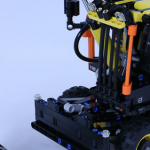42055 Bucket Wheel Excavator review
This mighty machine is the flagship of the 2016 Technic range. But should fans dig deep in their wallets for the 42055 Bucket Wheel Excavator or is it just a load of rubble?
Price: £179.99 / $279.99 / €229.99 Pieces: 3927 Available: Now
Over the past few years, the LEGO Group has gradually been pushing up the piece count on the Technic flagship sets. In 2011, the 2,000 piece barrier was broken by the mighty 8110 Unimog. A couple of years later that was raised to 2,600 pieces with the 42009 Mobile Crane MkII. In 2015, the line was pushed on another hundred pieces or so, with the 42043 Mercedes-Benz Arocs. But clearly this ‘edging forward’ business wasn’t enough for the Technic design team, and so this year they filled the kitchen sink with parts and put them all in a box.
The 42055 Bucket Wheel Excavator (BWE) comes in at a staggering 3,927 pieces and sits, at the time of writing, in the top ten largest LEGO sets ever created. So what are you getting for your money?
Actually, while we’re talking about money, nearly 4000 parts for £179.99 works out at around 4.6p per piece. For many people anything below 10p per piece represents solid value for money. Admittedly nearly 1500 of those parts are made up of just three different types of connecting pin, but a part is a part is a part, and any Technic builder will tell you that those pins are rather important.

Opening the box up we have 31 bags, numbered one to eight, with the bags for steps one to three in a smaller box. There is also an XL motor, a battery box and, in a sealed bag, the sticker sheet and manual – a manual that should come with a health and safety warning about keeping your back straight when you lift it. It’s 552 pages and is nearly an inch thick.
The build starts with a medium-sized dump truck. It’s the sort of truck that could reasonably be sold on its own as a sub £20 set. While it may not be loaded with features it does have working steering thanks to a Hand of God mechanism, and a tipper body that raises and lowers. A nice little build and a nice little model, but here it’s just an entree before the main course.
The truck has both tipper function and working steering.
The BWE itself consists of a tracked platform with a turntable. On top of this is a rotating superstructure with the main bucket wheel arm and conveyor belt, which can be raised and lowered manually. Below this, there is an independently controlled conveyor for offloading the excavated rock into the waiting dump truck.
Construction begins with the tracked platform – a solid, workmanlike build. It’s representative of most of the build process actually, with nothing standing out as exceptional or groundbreaking. There’s just a lot of it. An hour or two later and you’re looking at a solid base for the vehicle that measures around 26cm x 28cm. Of most interest will be the main turntable drive mechanism which is created from four of the new 1/4 Circle Gear Rack 11×11 pieces. First impressions suggest that this is a fairly specialised part that will have limited use, but never underestimate the ingenuity of the LEGO community.

Next up is the base of the machine itself which contains some relatively complex gearing, although anyone who has built the Mercedes Benz AROCS will brush it off as fairly straightforward. Much of this gearing takes care of the rotation of the superstructure, the movement of the lower conveyor and finally the drive to the tracks. Incidentally, only one of the axles is driven, something we’ll return to later.
The next stages proceed quite quickly, as the sides of the bodywork and the lower conveyor are built predominantly from large frames and plates, making progress swift. The conveyor has 180 degrees of movement, allowing the dump truck to be filled from either the rear of the machine or from either side. It will ultimately be controlled manually in a satisfyingly smooth fashion by a gear wheel at the rear.

We are now up to bags six to eight, these are used to create the main arm with the bucket wheel that does the excavating, and the upper conveyor that feeds the ‘rocks’ back down to the rear conveyor then ultimately into the truck. The rear half of the arm is home to the battery box, the main gearbox and control panel, also serving as a counterbalance for the bucket wheel. The whole assembly from battery box to the tip of the furthest bucket measures a mind-boggling 75cm.

It’s undoubtedly an interesting build. If you race though it an experienced builder could probably complete it – including the 30-odd stickers – in around seven hours. I’d suggest taking your time and enjoying the process.
So once the nigh-on 4000 parts have been assembled, what do we have?
It’s an impressive thing to see. LEGO fan or not, people will stop and examine this huge creation. Irrespective of how many functions it has, it looks complicated. With gearwheels, levers, tracks, belts and any amount of greebling, it invites peering, poking, prodding and demands for a demonstration. And that’s where it falls down slightly – its appearance is writing cheques that its functions can’t quite cash.
Don’t misunderstand, it has plenty of functionality, but much of it is a struggle. Everything on the BWE is run from a single large Power Functions (PF) motor which sits at the back of the arm near the battery box, thus power is having to be transferred over quite long distances. Every joint that the power delivery passes through, particularly where it changes direction, introduces degradation in the supply. Starting with forward and reverse motion, the power train runs half the length of the upper arm, turns through ninety degrees, runs down to the caterpillar tracks and is then taken through another ninety degrees back to the rear – and only the rear – axle. The BWE moves in a juddering fashion and it’s painful to watch as you can feel the strain on each gear, connector and axle. You don’t run it for long for fear of stripping a gearwheel.

The main bucket wheel and both conveyor belts are more successful. All run from the same switch, the bottom belt running slightly faster in comparison with the slower, more deliberate upper belt and digging mechanism. It rotates at around six rpm and is relatively smooth with just the odd stutter here and there. The whole arm assembly can be raised and lowered courtesy of a pair of linear actuators that are manually activated by a small gear wheel. These have a good amount of travel, taking the arm from almost horizontal down to around 45 degrees, meaning the buckets can just brush the ground. While the bucket and belts are running, the whole superstructure can be rotated in either direction. Sadly you can’t rotate the upper structure at the same time as moving the vehicle – but hey, you can’t have everything.

On the lower conveyor belt there’s a second set of switch gears which should, in theory, activate a neat mechanism. When the machine is in action, the main wheel and belt will excavate rock, transfer it down to the second belt and into the waiting truck. However, if the arm rotates, then the second belt will swing away from the truck. The lower switch gear should lock the lower arm in position so that it remains fixed over the truck even when the superstructure is rotating. In practice, this doesn’t happen. I’m willing to put it down to a mistake in my construction, but I’ve heard similar stories from other builders, so it may be a case of overreaching slightly by the designers.

And that’s probably the overarching feel about 42055. As a model it’s hugely impressive, but the size makes it very difficult to display. As a functioning Technic set, it seems to be trying to do too much with too little. The addition of a second motor would probably reduce some of the strain by splitting the load and making some of the power trains shorter.

Die-hard Technic fans will ignore all the criticisms and have probably not only bought this already but will be working on modifications and improvements to solve some of the issues we’ve talked about. But for those who are wavering… £180 is a lot of money to spend on a set that has limited play value, is awkward to put on show due to its size, and struggles to carry out the functions for which it’s designed.
So if you’re a Technic collector – buy with a small degree of caution. For anyone else, it would be harder to recommend.
42055 Bucket Wheel Excavator is available now from shop.LEGO.com. You can help support Brick Fanatics’ work by using our affiliate links.
This product was provided for review by the LEGO Group.
Author Profile
-
After a Dark Age lasting three decades, I discovered Technic in 2012, and was hooked. I sideline in Architecture and dabble in the odd Star Wars set (Holy Trinity only), but that's about it.
I love building Lego and I love writing about Lego (there's a link to my blog here somewhere) but it has to compete with videogaming, juggling, cooking, cycling and a desire to write the next great novel.
Very easy going, expect where spelling and grammar are concerned!











